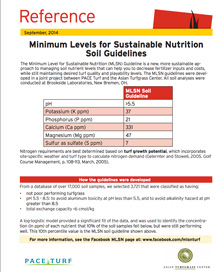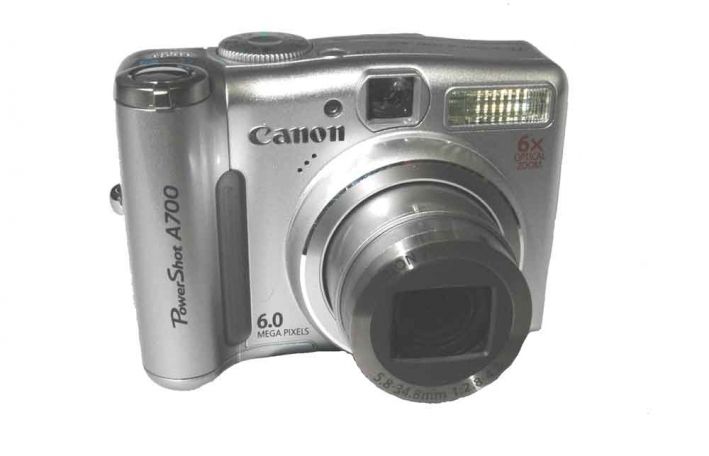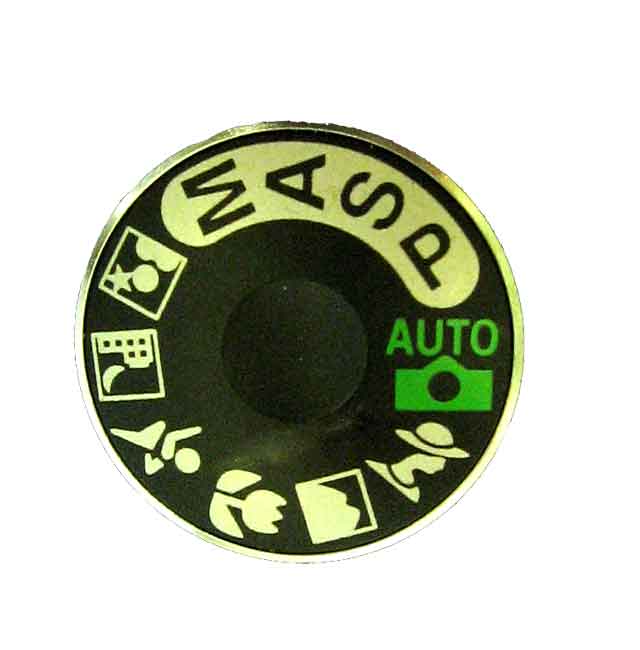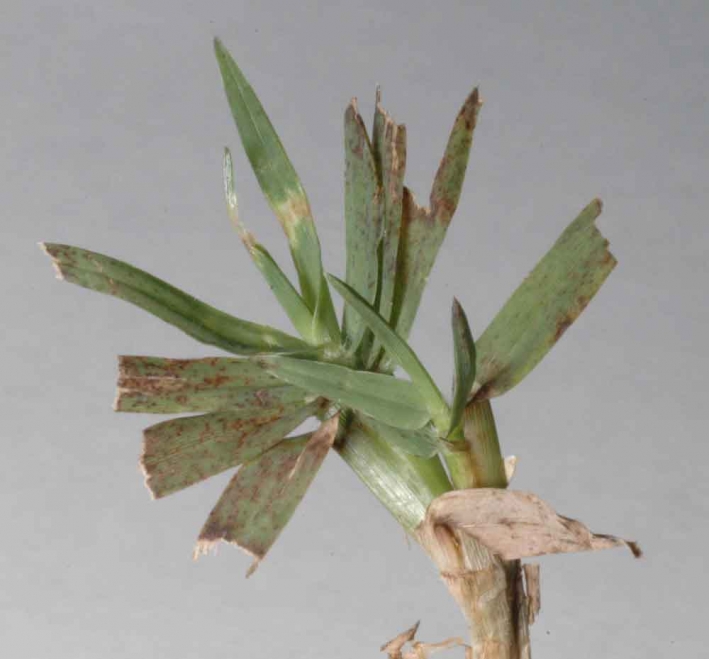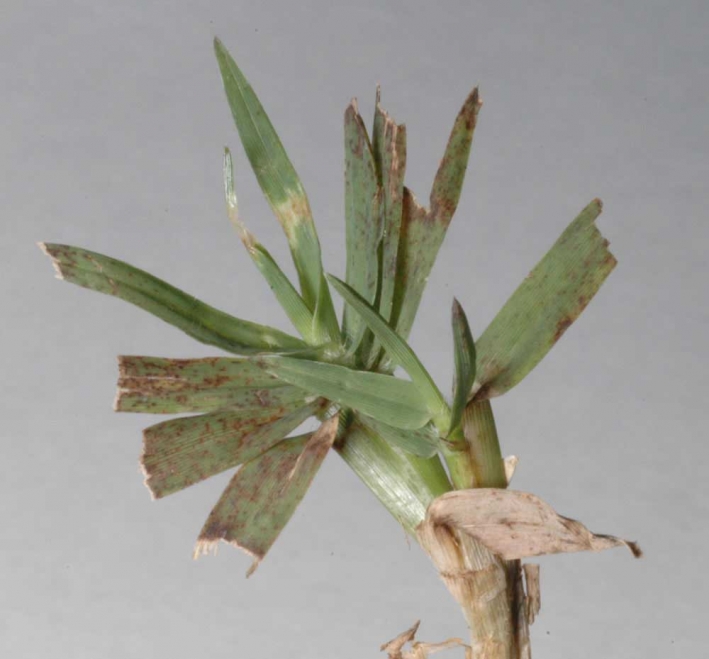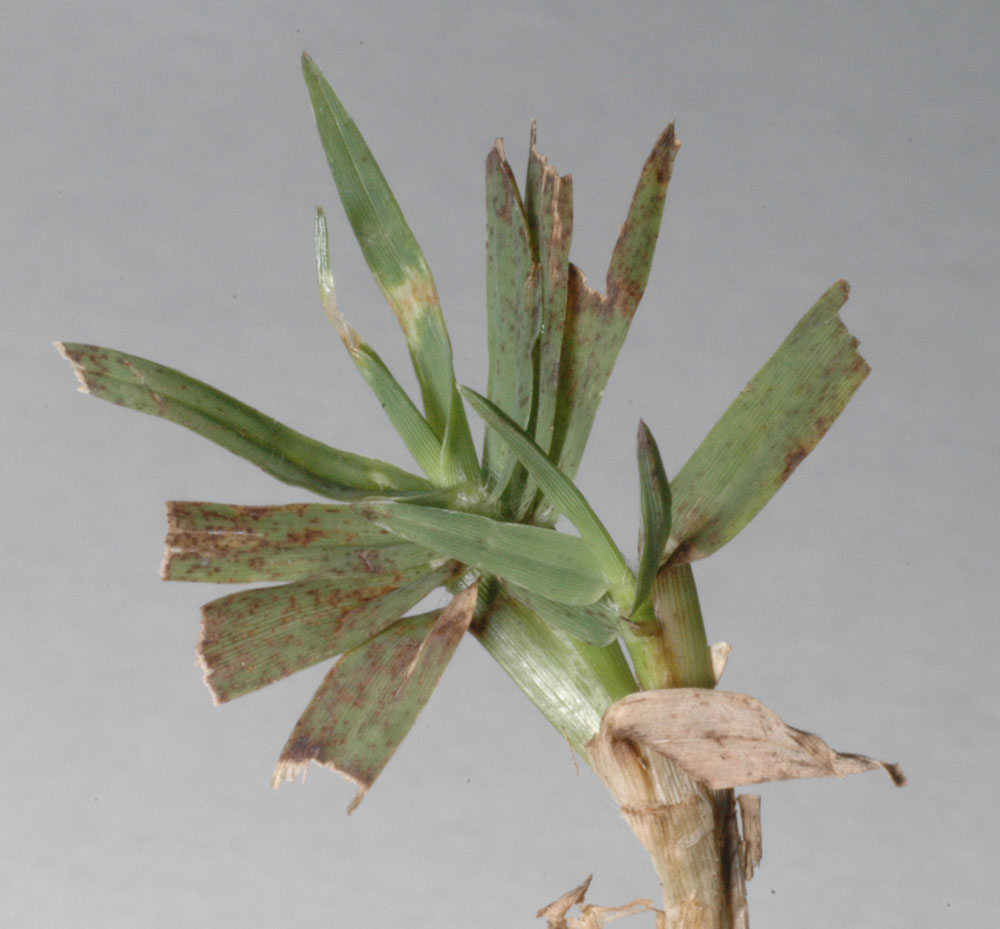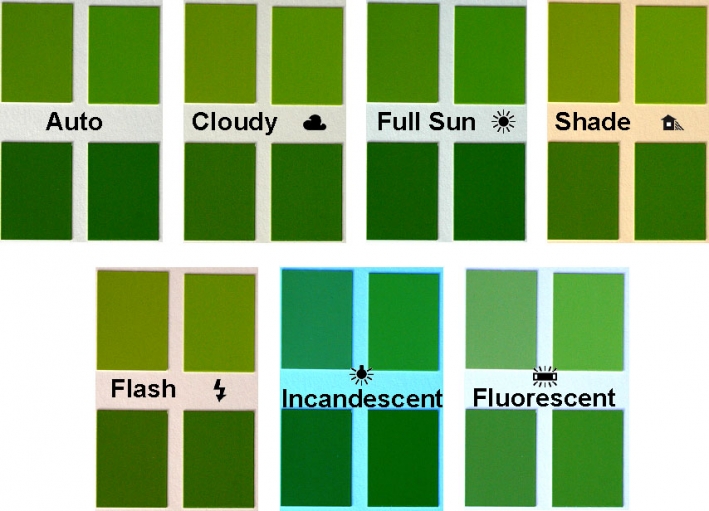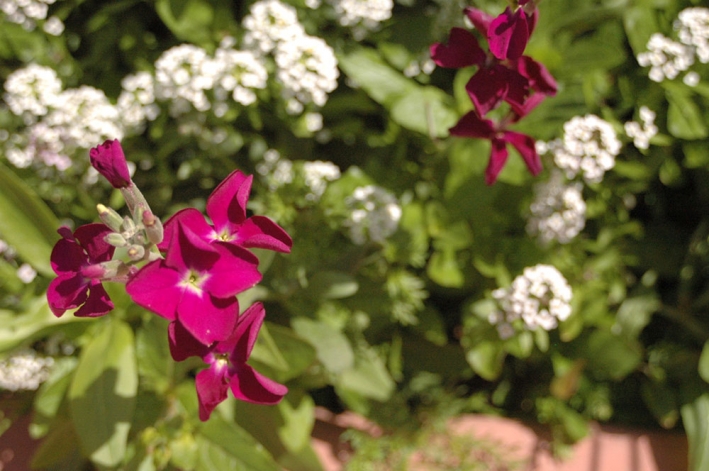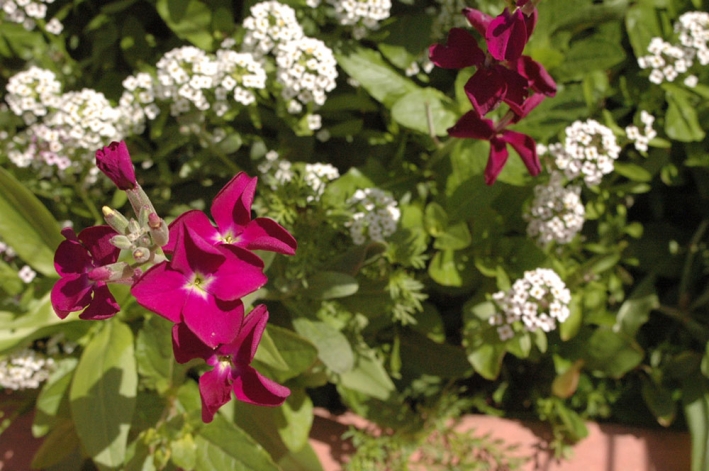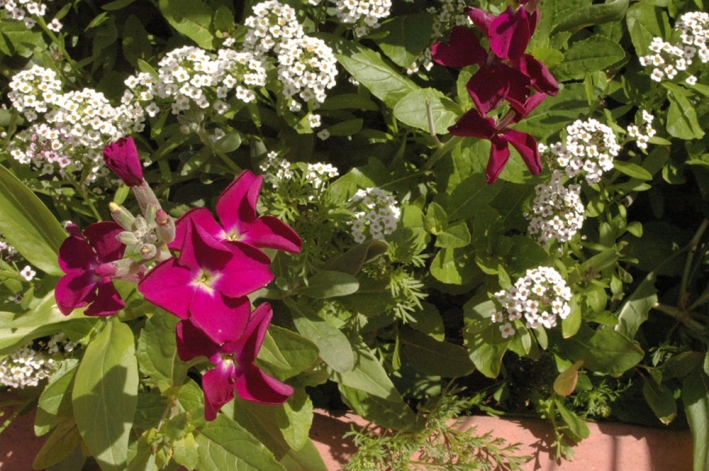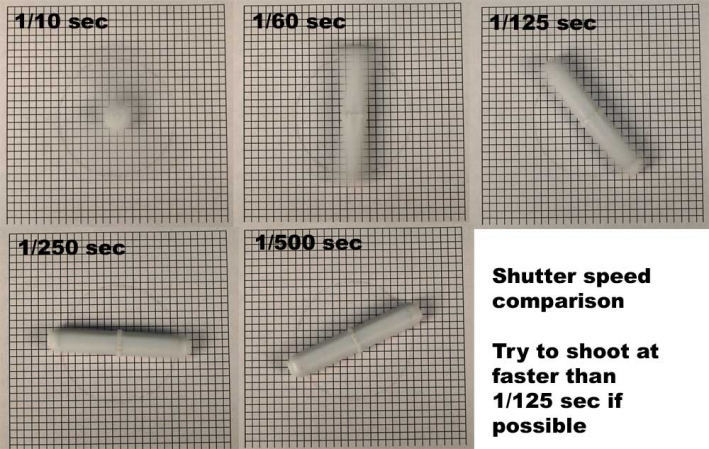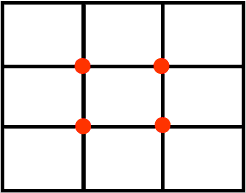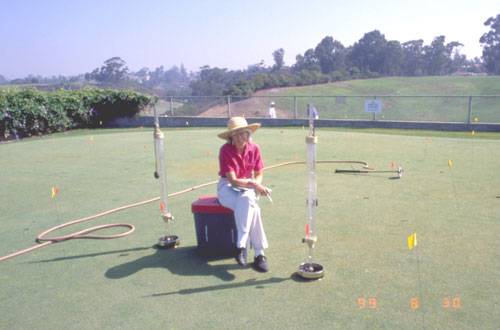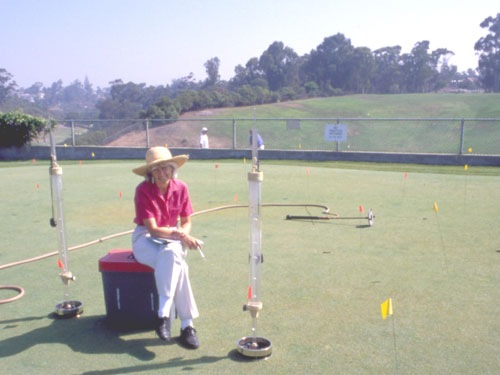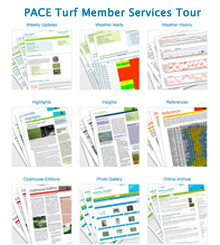University Field Days
This is not a comprehensive list, but we will add Field Days to this list as we become aware of them. Please let us know if you've got one that should be added to the list.
July 30, 2024: Rutgers Field Day 1, Hort Farm 2, N. Brunswick
July 31, 2024: Rutgers Field Day 2, Adelphia Farm, Freehold
To find a university location where turfgrasses are grown and evaluated with a climate similar to your's, see our university research location climate appraisals.
Turf Diagnostic Labs
If you are in any doubt about the identity or cause of a turf problem, we highly recommend the use of a qualified turf diagnostician. Fortunately, there are several good labs around the U.S. who provide this service. Check with your local land grant university and/or county extension agent for information on regional diagnostic laboratories. If none are available, the following labs provide nationwide services for reasonable fees. Labs should be contacted prior to sample shipment for specific preparation and shipping instructions.
Dr. John Kaminski
Turfgrass Pest Diagnostic Lab
Penn State 11 Tyson Building
1971 Shortlidge Road University Park, PA 16802
Phone: (814) 863-0918
Email: TurfPestLab@psu.edu
Website: Turf Pest Diagnostic Laboratory
Dr. William Crow
Dept of Entomology and Nematology
Univ. of Florida
General: P.O. Box 110620, Gainesville FL 32611
Shipping: 1881 Natural Area Dr., Gainesville FL 32611
Phone: 352-392-1994
Service offered: ID of plant parasitic nematodes
Email: Nemalab@ifas.ufl.edu
Website: University of Florida Nematode Assay Lab
Dr. Ruying Wang
Oregon State University
Turfgrass Diagnostic Lab
33329 Peoria Rd
Corvallis, OR 97333
Email: beaverturf.lab@oregonstate.edu
Website: OSU Diagnostic lab
Dr. Philip Harmon
Rapid Turfgrass Diagnostic Service
University of Florida Extension Plant disease Clinic
Building 78, Mowry Road
Gainesville, FL 32611-0830
(352) 392 1795
Website: Rapid Turfgrass Diagnostic Service
Dr. Jim Kerns and Lee Butler
NC State Turf Diagnostic Lab
1575 Varsity Drive
Suite 1575
Module 6
Raleigh, NC 27695
PHONE: 919-513-3878
Service offered: ID of insect and disease pests
Website: North Carolina State University
Dr. Lee Miller
Dept. of Botany & Plant Pathology
Purdue Plant and Pest Diagnostic Lab
915 Mitch Daniels Blvd - LSPS 116
West Lafayette, IN 47907
Email: turf-samples@purdue.edu
Website: Plant and Pest Diagnostic Laboratory
Clarissa Balbalion, Director
Plant Disease and Nematode Diagnostic Laboratory
190 Bost-North Room, 9
Mississippi State, MS 39762-912
PHONE: 622-325-2146 Nematology: 662-325-8336
Website: Misissippi State University Plant Diseases and Nematode Diagnostic Services
Dr. Kate Entwhistle
The Turf Disease Centre
Waverley Cottage, Sherfield Road
Bramley, Hampshire RG26 5AG ENGLAND
PHONE: 01256 880246
Service offered: disease and nematode ID on turf samples from all countries, with the exception of the U.S. and Canada.
Website: Turf Disease Centre
Philip Lujan
New Mexico State University Plant Diagnostic Clinic
945 College Ave.
Skeen Hall N140
Las Cruces, NM 88003
PHONE: 575-646-1822
Service offered: disease diagnosis
Website:NMSU Plant Clinic website
Richard Buckley
Rutgers Plant Diagnostic Laboratory
Ralph Geiger Turfgrass Education Center
20 Indyk-Engel Way
New Brunswick, NJ 08901
PHONE: 732-932-9140
Service offered: ID of turf diseases
Website: Rutgers Diagnostic Lab
Dr. Paul Koch (@uwpaul) and Kurt Hockemeyer (@kurtaculous)
University of Wisconsin
2502 County Highway M
Verona, WI 53593
PHONE: 608-845-2535
Website: University of Wisconsin Website
GPAvatar
![]() Have you ever been interested in the turfgrass growth potential (GP) for a location where research has been conducted or where a colleague is located? If you have, then you will appreciate the GPAvatar application.
Have you ever been interested in the turfgrass growth potential (GP) for a location where research has been conducted or where a colleague is located? If you have, then you will appreciate the GPAvatar application.
The GPAvatar app provides a rapid way to generate simple GP graphs for most US zip codes, and with the "Enter your climate data" option in the app, GP graphs can be generated for any location. If you are a Twitter user, you can download the GPAvatar graph to use as your Twitter icon to let the world know your turfgrass growth potential at a glance. To stimulate lunch-time conversation, print the GP graph and post it on the lunch room referigerator to see if anyone can figure out what it represents. This might help staff appreciate turf growth conditions throughout the year and when the grass is stressed.
University research location climate appraisals
University research results are valuable tools for developing turfgrass management plans. One way to bring more confidence in application of university research data to your site is to understand the type of climate (cool season, warm season or transition) each research location is located in. This PACE Update provides climate appraisal information for most of the major universities to allow you to compare your climate to each of the university research locations. Compare the GP Avatars (Growth Potential Avatars) for each university's location below to your own, provided on the PACE Turf Weather page. For more in-depth comparisons, you can also compare the Climate Appraisals, nutrient plans and normal weather patterns for each university vs. those provided for your location on your PACE Turf Weather page. In addition to reviewing climate impacts when reviewing research on variety trials or disease control practices, you can compare experimental nutritional inputs to the expected turfgrass use in the nutrient plans at each location to help better evaluate the value of these models and how they might apply to your location.
| GP Avatar | Location | Climate US or Metric | Nutrient plan C3 US or Metric | Nutrient plan C4 US or Metric | Delta GP (C3-C4) | |||
| University of Arizona | US | Metric | US | Metric | US | Metric | Delta | |
| University of Arkansas | US | Metric | US | Metric | US | Metric | Delta | |
| UC Riverside | US | Metric | US | Metric | US | Metric | Delta | |
| Colorado State University | US | Metric | US | Metric | US | Metric | Delta | |
| University of Georgia | US | Metric | US | Metric | US | Metric | Delta | |
| Purdue University | US | Metric | US | Metric | US | Metric | Delta | |
| Iowa State University | US | Metric | US | Metric | US | Metric | Delta | |
| University of Maryland College Park | US | Metric | US | Metric | US | Metric | Delta | |
| University of Massachusetts Amherst | US | Metric | US | Metric | US | Metric | Delta | |
| University of Michigan | US | Metric | US | Metric | US | Metric | Delta | |
| Universiy of Nebraska | US | Metric | US | Metric | US | Metric | Delta | |
| Rutgers University | US | Metric | US | Metric | US | Metric | Delta | |
| New Mexico State University | US | Metric | US | Metric | US | Metric | Delta | |
| North Carolina State University | US | Metric | US | Metric | US | Metric | Delta | |
| Ohio State University | US | Metric | US | Metric | US | Metric | Delta | |
| Oregon State University | US | Metric | US | Metric | US | Metric | Delta | |
| Pennsylvania State University | US | Metric | US | Metric | US | Metric | Delta | |
| Clemson University | US | Metric | US | Metric | US | Metric | Delta | |
| Texas A&M University College Station | US | Metric | US | Metric | US | Metric | Delta | |
| Utah State University | US | Metric | US | Metric | US | Metric | Delta | |
| Virginia Tech | US | Metric | US | Metric | US | Metric | Delta | |
| University of Wisconsin | US | Metric | US | Metric | US | Metric | Delta | |
MLSN Guidelines
Increased economic and environmental pressures have caused many turfgrass managers to re–assess the way you manage turf. With fertilizers as one of the bigger inputs, we felt that it was time to review and revise our current soil guidelines to reflect these changes. The result is the "Minimum Level for Sustainable Nutrition" (MLSN) soil guidelines, a new, more sustainable approach to managing soil nutrient levels that can help you to decrease inputs and costs, while still maintaining desired turf quality and playability levels. Used in conjunction with Climate Appraisals and Growth Potential, annual fertilizer needs can be estimated.
Working together with Dr. Micah Woods of the Asian Turfgrass Center, the guidelines were produced through review of key soil nutrient data from thousands of turf soil samples. Based on our evaluations, we determined that in many cases, guidelines could be safely lowered without a dramatic impact on turf quality or playability.
Since their introduction in 2012, the MLSN guidelines have been adopted by turf managers around the world, who have been surprised to find just how "low they can go" as they more precisely target the nutrient levels that the turf needs.
Scientific basis for the MLSN Guidelines:
- Woods MS, Stowell LJ, Gelernter WD, 2016. Minimum soil nutrient guidelines for turfgrass developed from Mehlich 3 soil test results. PeerJ Preprints 4:e2144v1 https://doi.org/10.7287/peerj.preprints.2144v1
- Stowell, L. and Woods, M. 2014. Minimum levels for sustainable nutrition. Bouyoucos Conference
- Stowell, L., Woods, M. and Gelernter, W. 2014. Only what the turf needs: updating the Minimum Levels for Sustainable Nutrition Guidelines. Crop Science Society of America meetings, November 5, 2014.
Turf management articles about the MLSN Guidelines:
- Woods, M. 2018. New MLSN Cheatsheet. Asian Turfgrass Center
- Woods, M., Stowell, L. and W. Gelernter, 2014. Just what the grass requires: using minimum levels for sustainable nutrition. Golf Course Management, January, 2014.
- Haines. J. 2014. Sustainable fertilizer use.
- Thayer, A., 2013. Cut costs with better turf management. Western Turf, Winter, 2013.
- Gelernter, W., Stowell, L and Woods, M. 2013. Documenting your progress toward sustainability. Golf Course Management, December, 2013.
Websites with more information about the MLSN Guidelines:
PACE Turf Video Library
We are proud of our extensive library of PACE Turf videos. The index below will be updated as we add more videos so that you don't miss a single thrilling episode! Be sure to subscribe to the PACE Turf YouTube channel and click the bell to ensure you get a notification for each new video release.
CHEMISTRY
- General: Avogadro, moles and valences
- pH: pH: An introduction
- pH:Measuring pH
- Potassium: Video Interview with the Experts: Dr. Micah Woods discusses potassium fertilization and soil test interpretation
- Sodium: Sodium accumulation
CULTURAL PRACTICES
- Cup Change Grain Problem
- Poa and low nitrogen
- Poa annua drought stress
- Poa Toupee
- Against the Grain
- Monitoring for soil salinity
- Kikuyugrass aeration and topdressing
- Localized dry spot and root zone depth
- Failure of poa in greens surrounds
- Fall aeration triggers a disease outbreak
- Organic matters
- Organic fertilizer surprise
- GPS, GIS and sand pits
- Sand quality control
- Aeration: avoiding the polka dot effect
- Severe layering in a bentgrass green
- Traffic control
DISEASES
- Algae: Cyanobacteria, aka algae, on Tyee bentgrass
- Algae: Algae, blue green bacteria, cyanobacteria and yellow spot
- Anthracnose: Early spring anthracnose
- Anthracnose: Anthracnose control failure
- Bacterial wilt: Diagnosing bacterial wilt
- Bentgrass diseases: Summer patch on bentgrass
- Brown ring patch (Waitea): Brown ring patch in June
- Brown ring patch (Waitea): Brown ring patch diagnosis
- Dollar spot: Dollar spot diagnosis
- Fairy ring: Diagnosing fairy ring -- again (summer, 2010)
- Fairy ring: Identifying fairy ring symptoms
- Fairy ring: Fall fairy ring
- Gray leaf spot: Gray leaf spot diagnosis
- Gray leaf spot: Gray leaf on St. Augustingegrass
- Leaf blight: Leptosphaerulina leaf blight
- Microdochium patch (pink snow mold): Microdochium patch diagnosis
- Preparing and shipping diagnostic samples: Packaging turfgrass diagnostic samples
- Pythium: Diagnosing Pythium blight
- Pythium on bermudagrass, 2009: Autumn surprise (Pythium on bermudagrass)
- Pythium blight on bermudagrass, 2010: Autumn surprise (Pythium on bermudagrass);
- Rapid blight: Diagnosing rapid blight
- Rapid blight: Rapid blight can look like Microdochium patch (pink snow mold)
- Rapid blight: Rapid blight invades colorado
- Rapid blight and fairy ring: Double Whammy
- Spring dead spot: Spring dead spot diagnosis
- Southern blight: Southern blight diagnosis
- Summer patch: Summer patch diagnosis
- Summer patch: Late-season summer patch
- General diseases: Mad tiller disease, rabbits and Southern blight
GOLFER EDUCATION
- Golfing on Dead Grass
- Golfer education on heat and turf damage
- Golfer education on frost delays
- Golfer education on aeration
- Golf: it's not just a game
THE INDUSTRY
INSECTS
- Billbugs: Identifying billbug damage
- Billbugs: Billbugs in sod, the gift that keeps giving
- Root Mealybugs
- White grubs: What makes a grub a grub?
- White grubs: Sampling for white grubs
- Wireworms
- Ground Pearls
NEMATODES
- A search for the source of nematode damage
- Free living nematodes
- Root knot nematode
- Putting out a biorational nematicide trial
- Root knot nematode on bentgrass
SOILS
- Soil amendments: Gypsum vs. calcium sulfate anhydrite
- Soil amendments: Quick test for gypsum products
- Compaction: Compaction relief with deep tine aeration
- MLSN Guidelines: Minimum levels for sustainable nutrition: the calcium guideline
- MLSN Guidelines: Tales from the field—phosphorus, take all patch and MLSN
TOOLS
- Using drones as alternatives to aerial photography
- Knockout trials (doing your own research)
- Calibrating your EC meter
- Measuring soil moisture with Turf Guard vs. Spectrum TDR-300
- The iStimp arrives: for better or worse
- iStimp Field Evaluation
- Golf Course Sustainability Metrics
- Turf Covers at Del Mar Thoroughbred Club
- John Turnour on Turf Covers
WATER MANAGEMENT
- Dr. Leinauer on water conditions
- Bryozoans clogging irrigation systems: Unwelcome bryozoan guests
WEATHER
- Climate in Motion
- Heat and drought recovery
- Purple bentgrass and cool temperatures
- Using threat temperatures to prevent disease outbreaks
- Using degree days to time poa suppression applications
- Summer has arrived: Disease, insect and drought damage that results when hot weather arrives
- Wind can save the day
- Spring (2012) has sprung
- The role of sunshine in turfgrass health (Video interview with Dr. Micah Woods).
- Water use alert
WEEDS
- Poa annua: Iron, phosphorus and poa
- Poa annua: Extreme measures: poa control at Big Canyon Country Club
- Poa annua: Weather changes trigger poa color variation
Sand and Growth Potential

The sand topdressing spreadsheets provided in this PACE Update have been modified to increase initial maximum sand application per month from 150 lbs dry sand/1000 sq ft to a higher maximum monthly application rate of 300 lbs dry sand/1000 sq ft (150 kg/100 m^2). This adjustment was made following discussion with Dr Micah Woods at the Asian Turfgrass Center and Micah's review the literature for more locations and turf types. This increase in maximum sand applied per month brings application rates more in line with current recommendations for a variety of locations for cool and warm season grasses. In a summary of Light and Frequent Topdressing Programs written by Whitlark and Thompson, between 25 and 35 cu ft of sand per 1000 sq is a good annual target (7.8 - 10.9 mm), but there was no site-specific recommendation on how the applications might be delivered over time depending upon environment or turf type. The 4.2 l/m^2 per year (4.2 mm sand per year) applied to suppress anthracnose recommended by Hempfling et. al. may not be sufficient for organic matter management in bentgrass in New Jersey or for bermudagrass grown in other locations. The initial recommended sand application rate of about 7.8 - 10.9 mm per year by Whitlark and Thompson is much lower than sand topdressing rates recommended target of 24 mm sand per year that was recommended by William Davis at the University of California in 1978. With all of these different recommendations, what's a turf manager to do?
The use of Growth Potential provides a way to anticipate and budget application volumes to match turfgrass growth. Adjustments should be made to match the needs of each site depending upon the turf type, financial considerations and tolerance for sand applications by golfers. The initial values for maximum sand application are a compromise and a starting point to help you dial in the expected sand requirements for your location.
Light and frequent sand topdressing is a great tool to improve greens surface firmness, for poa greens to suppress anthracnose, and to help manage organic matter at the surface of the green. But how much sand should be applied?
Ideally, topdressing sand would be applied at a rate that matches the deposition of organic matter as leaves, stems and roots senesce and decay. To get a rough idea of how much sand to apply over the course of the year, we have developed a simple US units spreadsheet and metric units spreadsheet that use growth potential (GP) as a guide, and a maximum sand application of 300 lbs dry sand/1000 sq ft per month (150 kg/m^2 per month) at maximum turf growth. The spreadsheets use monthly average temperature to calculate growth potential and then growth potential to determine the sand application rate. For weekly applications, divide the monthly application rate by four.
- Try the new sand topdressing rate US units spreadsheet
- Try the new sand topdressing rate metric units spreadsheet
- Reference on Turf Growth Potential (GP)
- Reference on topdressing sand
PACE Weather
 PACE Turf has upgraded it's weather services to include the Weather Underground Personal Weather Station (PWS) dataset. This addition will allow you to select one of the 250,000 weather stations worldwide that might be closer to you than one of the regional airport weather stations. You can also add a weather station at your site that can be accessed through the Weather Underground PWS system (Personal Weather Station Buying Guide).
PACE Turf has upgraded it's weather services to include the Weather Underground Personal Weather Station (PWS) dataset. This addition will allow you to select one of the 250,000 weather stations worldwide that might be closer to you than one of the regional airport weather stations. You can also add a weather station at your site that can be accessed through the Weather Underground PWS system (Personal Weather Station Buying Guide).
To find a nearby station, browse to Wundermap and enter your city or navigate around the map to find a location station near you. Once you have found a station, click on the numbered tag to reveal the personal weather station ID number. Follow the instructions below to change the alternate weather station in your PACE Turf profile.
Steps for changing your weather data source location to a PWS:
- Browse to Wundermap and find the PWS that you are interested in.
- Click on the small numbered tab to open the PWS details. Note the station ID. It will be something like KCASANFR957. Copy the station ID to use in your PACE Turf profile. Please copy it, and don't try to enter the station number manually in step 5 below, because it's sometimes impossible to tell whether the symbols in the station code refer to a number (such as the number one) or a letter (such as the lower case letter "l").
- Log into your PACE Turf account and click on My Account located in the blue box at the top of the page.
- When you are in the My Account page, click on the Edit Profile link below the Member Links heading on the right side of the page.
- In the Alternate Weather Station entry box, type pws: and then PASTE (don't manually enter) the station ID you copied from WunderMap (it should look something like this: pws:KCASANFR957).
- To be sure the system is working properly click on "Weather" located in the green navigation bar near the top of the PACE Turf webpage. If you receive a list of error messages, there is a problem with the weather station information entered into the Alternate Weather Station box. If this is the first time you have entered a new station location, there may be a delay of several seconds as the PACE server caches the weather data. Once you successfully enter an Alternate Weather Station all data for future PACE Turf email Weather Alerts will be sourced from the new location.
- Contact Us if you have any questions.
Use Bayer Rewards points for PACE Turf membership
For those of you that are participating in the Bayer Rewards (Accolades) program, we are pleased to announce that you can now use your points to purchase PACE Turf memberships.
Just login to the Bayer Rewards website, and click on the "Catalogue" button. Then, click on the "Tools of the Trade" category in the left menu bar. You will see the PACE Turf membership option listed there.
iPad2 Giveaway
iPAD2 Giveaway Winner Announced!
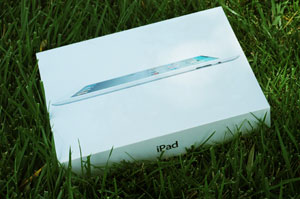
Congratulations to Ken Newcomb, Coto De Caza Golf and Racquet Club
The 2011 PACE Turf iPad2 Giveaway introduced more turf management professionals to PACE Turf and social networking sites such as Facebook. More than 350 people liked the PACE Turf on Facebook. Thanks for your participation!
The PACE Turf Facebook page provides samples of information from the PACE Turf website and YouTube channel that are of interest throughout the year. If you like what you see, please take the tour and consider joining PACE Turf - the most comprehensive and well organized technical resource for turfgrass managers.
Top Ten Turf Monitoring Tools
OK, so we couldn’t stop at 10. Once we got started listing tools that we have found to be effective, that are easy to use and to acquire, and that are relatively inexpensive, we found at least 15 turf monitoring tools that we think should be in every superintendent’s arsenal.
This information was presented in the "Answers on the Hour" Session at the February, 2011 Golf Industry Show in Orlando. For those of you that didn’t attend the session, please feel free to download and print this handout (131 KB pdf) for further information.
Intrigued by the weird designs on the back of the handout? These QR codes are a type of bar code that can be rapidly scanned with your smart phone’s camera to gain immediate access to a website. The codes on the back of the handout correspond to the websites of each of the manufacturers listed on the front of the handout as sources for the tools that we recommend.
Although some phones have built in QR readers, iPhone users will need to download a QR application (usually free or under 2 dollars). To find out what you need for your phone, just do an online search for the model of your phone, followed by the words QR reader.
Not a PACE Turf member yet?
For more information on how PACE Turf’s member website, emails and videos can help you get the answers you need, please take the tour of PACE Turf member services, visit our home page or read what other turf managers have to say about the benefits of membership.
Hope to see you at the show!
We are looking forward to the GCSAA conference and show next week, and hope to see many of you there. We are teaching three different courses this year, and hope you'll have some time to stop by before or after one of the classes to say hello! (schedules and locations are listed below).
For those of you who won't be in Orlando this year, we're planning on reporting back on any new and worthwhile information that we can glean.
Monday, February 7, 9:20 – 9:40 am: "The latest dirt on dirt on sensor technology". Room W304 (F,G and H)
Tuesday, February 8, 1 – 5 pm: "Tools for Managing Economic Challenges: The IPM Planning Guide and Precision Turf Management". Room W311D
Wednesday, February 9, 2 – 2:30 pm: " Ten turf monitoring tools that you can't do without: a demonstration". Trade Show Floor, Booth 1585.
Background information on economics and environmental profile of the golf industry
With 16,000 golf courses spread throughout the U.S., the golf course industry impacts us in many ways. The articles below have been produced by researchers to measure the effect of golf courses on the economy, on the environment, and on the production of greenhouse gasses. Overall, the impact of the industry in all of these sectors is a positive one. See this video for more information.
The economics of the golf industry:
- Haydu, J.J., A.W. Hodges, C.R. Hall. 2008. Estimating the Economic Impact of the U.S. Golf Course Industry: Challenges and Solutions. HortSci. 43:759-763.
- Templeton, S.R., D. Zilberman, and M.S. Henry. 2010. Golf Courses in California as Modern Agricultural Enterprises, Agricultural and Resource Economics Update, Vol. 13, No. 3
- Templeton, S.R., M.S. Henry, J. Bihui and D. Zilberman. 2002. Economic Impacts of California's Golf Course Facilities in 2000. Research Report RR-02-01, Department of Agricultural and Applied Economics, Clemson University and Department of Agricultural and Resource Economics, University of California, Berkeley.
The role of golf courses in counteracting global warming:
- Milesi, C., Running, S.W., Elvidge, C.D., Dietz, J.B., Tuttle, B.T., Nemani, R.R, 2005. Mapping and modeling the biogecochemical cycling of turf grasses in the United States. Environmental Management 36(3):426-438.
- Rufty, T, Rees, R. and N. Hamon, 2010. Carbon footprints of urban landscapes. Golf Course Industry, August 13, 2010.
Efforts taken by the golf course industry to improve environmental stewardship:
- Property profile and environmental stewardship of golf courses, 2007. The Environmental Institute for Golf.
- Water use and conservation practices on U.S. golf courses, 2008. The Environmental Institute for Golf.
- Nutrient use and management on U.S. golf courses, 2009. The Environmental Institute for Golf.
- Energy use and conservation practices, 2012. The Environmental Institute for Golf.
- Pesticide use on U.S. golf courses, 2012. The Environemntal Institute for Golf.
A message from PACE Turf owners, Dr. Wendy Gelernter and Dr. Larry Stowell:
We hope that we have kindled your interest in PACE Turf's information service with the information above. If you join today, you will have immediate access to weekly emailed updates, educational videos, site-specific weather and pest forecasts, state-of-the-art web site and many other services that will help you to prevent turf problems before they occur, save you time and money, and keep you current with the newest management products and practices. At $275 per year, or just $ 0.75 per day, it's a bargain that you can't afford not to take advantage of!
For more information, please take the tour of PACE Turf member services, visit our home page or read what other turf managers have to say about the benefits of membership. Please also feel free to contact us at any time. We look forward to having you join us!
Soil Analytical Laboratories
Soil analytical laboratories
The following analytical laboratories conduct soil and water nutritional analyses. Many also conduct plant tissue analyses. PACE's guidelines for soil nutrition, irrigation water quality, and turfgrass tissues are available on this site. Please note that this is only a partial listing of analytical labs.
Brookside Laboratories Phone: 419-753-2448
Logan Labs Phone: 937-842-6100
Servi-Tech Laboratories Phone: 800-557-7509
Waypoint Analytical Phone: 800-264-4522How we review products and practices
Selecting which product or practice will perform the best for you is one of the most important — and also one of the most difficult— decisions that turf managers face. The fact that some materials are marketed with little or no data, or with misleading data, complicates your decision ten-fold.
One of our main goals is to supply PACE Turf members with science–based guidance on the efficacy of turf products, practices and management strategies. Whether we are reviewing the performance of gray leaf spot control agents, sod webworm products or strategies for moss control, we always provide a listing of the options that will perform best, in our analysis.
But how do we determine which strategies to recommend, and which to omit from our publications and presentations? The internal guidelines shown below were developed here at PACE Turf over the past 30 years, and, because they are based in the scientific method, they give us confidence that the recommendations that we pass along to you are as useful and dependable as possible. The guidelines below may also be useful to each of you in product selection decisions, as well as in communicating to vendors the standards that you will use to evaluate the products that they are promoting.
PACE Turf internal guidelines for development of turf management recommendations:
- Each research trial must have a detailed protocol that describes the objectives of the study, as well as detailed materials and methods that include statistical analytical methods and experimental design parameters.
- Treatments must be replicated and include appropriate non–treated controls. In addition, current method(s) of choice should be included for purposes of comparison.
- Trials should be conducted, supervised or coordinated by a qualified independent researcher or consultant (university or extension researchers, Certified Crop Advisors, Certified Professional agronomists, Certified Soil Scientists, independent researchers with a minimum of a B.S. in agricultural or related sciences). Publication record in peer reviewed science journals is a plus. Unknown researchers are required to supply a resume and references with their research reports.
- Raw data must be provided by researchers to PACE Turf upon request. PACE Turf may re–analyze raw data to confirm conclusions.
- The product or practice should be tested in multiple locations (a minimum of 3) and, if feasible, in multiple environmental regions.
- Products that are selected for use in PACE Turf management recommendations must show a substantial positive effect. A statistically significant response alone is not sufficient, as it does not necessarily show that the product will provide a useful and practical solution for PACE turf clients.
- Data cannot be "cherry–picked" so that only favorable data is provided for review, and negative data is withheld.
Yes, we’re on Facebook!
We have joined the ranks of millions of Facebook users with PACE Turf's new Facebook page. Because it's so new, we are still adding to it, but we'd love to hear your feedback. If you are a Facebook member, you can do this by:
- Friending Larry
- Friending Wendy
- Leting us know if you like the new Facebook page by clicking on the "Like" icon at the top of the PACE Turf Facebook page
Not on Facebook yet? Neither were we, until recently. So far, we've had many different impressions — it's fun, it's perplexing, it's riveting, and it's definitely a potential black hole for your valuable time. But it's also a great resource for connecting with professional colleagues, as well as relatives and friends (both current and long–lost). It's free, it's easy to register, and worth a look. Hope to see you on the PACE Turf Facebook page soon!
IPM Planning Tools
IPM Planning can be a tedious task. However, once your first IPM Plan has been created, the major work has been done. The information provided below was developed for the first version of the GCSAA IPM Template. That planning template has not been supported by the GCSAA, but the information below is stil useful. We will be reviewing some of these resources and updating the documents throughout the year. We hope this information will assist you with development of a site-specific IPM plan for your location.
The spreadsheets, references and procedures below were developed, with support from a GCSAA grant, to assist superintendents in creating an IPM Plan for their golf courses. The project was completed and attempts to update the project have failed. However, the template draft and instructions below are still useful when developing an IPM plan for your facility.
Instructions for completing the IPM Template (291 KB pdf)
Pest, Soil and Water Management References (1.7 MB pdf)
The following forms are available for use in constructing your IPM Template
Electronic entry forms:
- Climate Appraisal Form: English units (electronic entry, 12 KB, xls file)
- Climate Appraisal Form: metric units (electronic entry, 12 KB, xls file)
- Goal Setting Form (electronic entry form, 82 KB doc file)
- Management Zone Inventory Form (electronic entry form, 108 KB doc file)
- Management Zone Performance Record (electronic entry form, Excel file)
- Electronic entry forms for IPM Planner, Pest Worksheet and Budgeting Worksheet (84 KB Excel File)
- Spreadsheet for tracking pesticide toxicity class totals (pounds) (Excel File)
- Spreadsheet for tracking pesticide toxicity class totals (kilograms) (Excel File)
- Spreadsheet for calculating pounds active ingredient in pesticide formulations (Excel file)
Printable forms:
- IPM Planner (printable form, 37 KB pdf)
- Pest Worksheet (printable form, 38 KB pdf)
- Budgeting Worksheet (printable form, 35 KB, pdf)
- Goal Setting Form (82 KB doc file)
- Management Zone Inventory Form (108 KB doc file)
Examples of completed forms for IPM Planner, Pest Worksheet, Climate Appraisal and Budgeting Worksheet
- Southern California:
- Southern California Pest Worksheet and IPM Planner (88 KB Excel File)
- Maryland: Maryland IPM Planning resources
- Vermont:
- Vermont Pest Worksheet and IPM Planner (57 KB Excel File)
- Vermont Climate Appraisal (12 KB Excel File)
- Illinois:
- Illinois Pest Worksheet and IPM Planner (52 KB Excel File)
- Budget Worksheet Example (Illinois) (Excel File)
- Spreadsheet for tracking pesticide toxicity classes (Illinois Example) (pdf file)
- Illinois Climate Appraisal (12 KB Excel File)
- Management Zone Performance Form Example (Illinois) (pdf)
Turf growth potentials: a tool with many uses
We developed the growth potential model to explain myriad of ways in which weather impacts turf growth. The model considers turf growth to be good when the growth potential (GP) is between 50% and 100% (the best possible growth occurs at a GP of 100%). However, when weather conditions are either too hot or too cold for optimal turf growth, the GP falls below 50%, and turf becomes progressively more stressed. When the GP falls to 10% or lower, growth is extremely limited. We have listed a few of the many uses of growth potentials below.
- Timing application for chemical transition accelerators (Kerb, Revolver, Monument, Manor, Blade, TranXit): Warm-season turf GP should be 50% or higher at the time of application in order to ensure that sufficient warm-season turf cover is present.
- Scheduling aggressive management practices (aerification) or stressful events (tournaments): Turf growth potential should be as high as possible (greater than 50%) and on the rise when stressful events are scheduled. This allows for the greatest recovery potential of the turf.
- Explaining why cool- or warm-season turf is performing poorly (or well).
- After a heat spell, predicting how long will it take for cool-season turf to begin active growth again.
Table of growth potential at different average air temperatures (pdf).
Table of growth potentials in selected US Cities (pdf).
Use GreenPartners points for your PACE Turf membership
We're happy to announce that PACE Turf memberships can now be paid for with points from Syngenta's GreenPartners rewards program. You can redeem your GreenPartners points for PACE Turf membership by phone or online:
- ONLINE:
- Go to the GreenPartners website where you can either login to redeem your points (if you are a GreenPartners member) or enroll.
- Enter "PACE Turf" into the search box of the Rewards Catalog. You can also find us under the category "Special Services" (item number 23332).
- BY PHONE: Call GreenPartners toll-free at 877-375-0824 and select option 4 from the menu. Place your order for the PACE Turf Membership, item # 23332.
A PACE Turf eMembership, normally priced at $275 per year, is worth 36,000 GreenPartners points
If you are not familiar with GreenPartners, it is Syngenta's customer appreciation program. Members of the program can redeem GreenPartners points for many different reward options, including, of course, the crème de la crème of their catalog — the PACE Turf eMembership.
Fungicide combination products: decision-making tools
Are they a gimmick by manufacturers, or a great new tool for turf managers? A prescription for fungicide overuse, or a more effective approach that takes advantage of fungicide synergies? These are just some of the questions raised as superintendents try to decide whether a fungicide combination product is the best choice for them.
To help you decide if any given combination product is a good choice for your situation, we have developed two useful tools:
- This PACE Turf Reference on Fungicide Combination Products (140 KB pdf) lists the active ingredients, and their concentrations, in commonly available fungicide combination products.
- This Product active ingredient calculation spreadsheet automatically calculates the rate of each fungicide active ingredient delivered to turf for any product that you are interested in. Calculations are available in both metric and English units.
A message from PACE Turf owners, Dr. Wendy Gelernter and Dr. Larry Stowell:
We hope that we have kindled your interest in PACE Turf's information service with the information above. If you join today, you will have immediate access to weekly emailed updates, educational videos, site-specific weather and pest forecasts, state-of-the-art web site and many other services that will help you to prevent turf problems before they occur, save you time and money, and keep you current with the newest management products and practices. At $275 per year, or just $ 0.75 per day, it's a bargain that you can't afford not to take advantage of!
For more information, please take the tour of PACE Turf member services, visit our home page or read what other turf managers have to say about the benefits of membership. Please also feel free to contact us at any time. We look forward to working with you soon.
Announcing the PACE Turf eMembership
Based on input from members who want the convenience, money savings and environmental sustainability of an all-electronic membership, PACE Turf is happy to announce its new, paperless eMembership option.
eMembers will receive all of the benefits of regular membership in PACE Turf, but with all services, including publications (Highlights, Clubhouse Editions, Insights and References) available exclusively online or via email.
PACE Turf will also continue to offer regular memberships, at $325 per year. This membership includes all eMember benefits plus print versions of PACE publications (Clubhouse Editions, Highlights, Insights, References and an Archive notebook) mailed to your address.
Benefits of eMembership:
- Simplify your life: reduce paper, mail and office clutter by printing out publications only when you need them.
- Save money: at $275 per year, eMembers will enjoy a 15% cost savings over regular membership. Discounts for 10 or more memberships are available; please contact us at pace@paceturf.org or 858-272-9897 for more information
- Help the environment: it’s amazing how many resources a paper mailing can generate, including fuel for air and ground freight, paper, envelopes, ink and electricity for printing.
- Continue to have the answers at your fingertips with PACE Turf’s state-of-the-art web and email member services, including:
- Email services: weekly Updates keep you current with breaking news on practices, research, pests and products and Weather Alerts (emailed 3 times per week) provide up-to-date pest, turf and weather forecasts customized for your location
- Online Weather Services: The Weather Update page provides forecasts of weather, turf growth and pest occurrence, and is updated several times a day for your location. The Weather History page gives you detailed information on past weather conditions at your location.
- The online Photo Gallery's hundreds of photos can be used for rapid pest ID and illustration of new techniques
- The online Member Forum allows PACE Turf members from around the world to easily communicate about new ideas, practices and products.
- Online publications can be printed out when and where you need them. Clubhouse Editions are one-page publications designed to educate golfers on the science behind your management practices. Highlights summarize key events of the past month in a 4-page color publication. References are essential tools for turf management, with publications on soil, weather and pest management guidelines. Insights are publications that translate science into practice with in-depth analyses of turf agronomic topics.
- The online Archive gets you the answers fast with a searchable library of hundreds of PACE Turf publications, research reports and references.
Interested in eMembership? For new members, just check the eMembership box on the online membership form. For renewing members, you will be given the option to switch to eMembership at the time of your next renewal.
Reclaimed water article published
An article summarizing over 10 years of PACE Turf's research on reclaimed water appears in the September, 2008 issue of Golf Course Industry. For more information on using and managing reclaimed water on golf course turf, see these PACE Turf publications:
- Agronomic guidelines: Irrigation water guidelines
- Super Journal article: Pennsylvania golf course water survey
- PACE Turf Update: Water blending spreadsheet (members only)
- PACE Turf Update: Impact of recycled water on IPM (members only)
- PACE Turf Update: New information on recycled water (members only)
Super Journal presentation on virtual irrigation and disease management
PACE Turf developed the virtual irrigation audit as a tool for diagnosing coverage problems with irrigation systems, and for predicting the performance of new irrigation systems even before they are installed. Recent data indicates that the system can also be used to accurately predict the location and the size of disease outbreaks.
To learn more, visit the Super Journal website, and read the report, "The Virtual Irrigation Audit: A Diagnostic Tool For Turfgrass Disease".
Soil guidelines
The PACE Soil Nutritional Guidelines are based on our soils database of over 15,000 samples.
For information on a variety of other turf management guidelines, click here.
2008 PACE Turf Research Seminar: thanks to all involved
The 11th PACE Turf Research Seminar, which took place on June 20, was a great success, thanks to the 160 attendees, the informative speakers, and the sponsorship of the companies below:
| Company | Representative |
|---|---|
| Aquatrols | Ken Mauser |
| BASF | Fred Eckert |
| Bayer | Stephen Kimball |
| Cleary Chemical | Robert Hunter |
| John Deere Landscapes | Bill Blackman |
| Milliken | Cordie Morgan |
| Syngenta | Kimberly Gard |
| Target Specialty Products | Tim Roth |
| West Coast Turf | John Marman |
| Western Farm Service | Geff Ward |
APS Turf Tour
On July 27, 2007, PACE hosted a turf tour for 35 plant pathologists who were in town for the American Phytopathological Society meetings. The participants, who came from all over the U.S., were able to view a cornucopia of turf types and turf uses — from the paspalum fairways of Fairbanks Ranch CC, to the GN-1 bermudagrass at the Del Mar Thoroughbred Club, to the kikuyugrass fairways at Torrey Pines GC, the poa/bent greens at Mission Bay GC and the overseeded Bullseye bermudagrass at Petco Park.
The all-day tour was a great success, thanks to the superintendents listed below who so graciously hosted us. We want to take this opportunity to thank them here for their time, their insights, and their generosity in sharing their experiences with all of us.
- Candice Combs, CGCS, Superintendent: Torrey Pines Golf Course
- Brian Darrock. Superintendent: Fairbanks Ranch Country Club
- Gerald Dearie, Superintendent: Mission Bay Golf Course
- Leif Dickinson, Superintendent: Del Mar Thoroughbred Club
- Mark Woodward, CGCS, Director of Golf Course Operations: Torrey Pines Golf Course
- Luke Yoder, Superintendent: Petco Park
Index of photography articles
PACE Mission
The PACE Turf information service delivers science-based solutions to turf management problems with breaking research news, information and expert advice that is customized for your location.
Leading experts at PACE Turf translate science into practical information that comes to you via emailed newsletters and weather alerts, a state-of-the-art website, and downloadable publications that you will refer to again and again in the development of your turf management programs.
WIN A CANON A700 CAMERA IN THE PACE IPM PHOTO CONTEST
Contest goals:
- To encourage turfgrass professionals and students to use their digital cameras more effectively
- To share turf IPM information and digital images with the turf management community
- To acquaint you with the PACE Turfgrass Research Institute Photo Gallery, a digital photo library that is available free of charge.
- To provide some prizes and to have some fun in the process!
Entry deadline: The contest runs from July 5, 2006 to September 15, 2006.
Prizes: Winners will be notified by email and results will be posted on the PACE website on October 1, 2006. Three winners will be selected. 1st prize: Canon Powershot A700 camera or a $300 gift certificate from 47th Street Photo ; 2nd prize: gift certificate for $200 at 47th Street Photo; 3rd prize: gift certificate for $100 at 47th Street Photo
What to enter:
- Each participant may submit only one digital or scanned photo in .jpeg (.jpg) format. We will not accept entries that are submitted via conventional mail/postal services.
- See our IPM Photography Tips for suggestions on taking a prize winning photo.
- Photos must illustrate a turf IPM topic, concept or practice (click here for examples)
- Photos may not exceed 1,000 X 1,000 pixels at 150 dots per inch (dpi). File size should be less than 200 KB.
- You must be the photographer and the sole owner of the submitted photo
Judging: The judges' decision is final. Photos will be judged by PACE Research Directors Dr. Larry Stowell and Dr. Wendy Gelernter and winners selected based on the highest scoring entries in the following areas:
- IPM subject matter (click here for a description of suggested topics)
- Value as an educational or informational tool
- Composition, pleasing appearance, interesting subject matter
- Lighting, focus, clarity of image
- Clearly written title (less than 5 words) and description of image (less than 50 words). Click here for tips on writing titles and descriptions
Use of submissions: All photos submitted for the contest will be made available on the PACE website’s Photo Gallery, and may be used by any interested person for non-profit educational purposes. Your photos will not be used in sales, advertising or marketing activities. Your photo submission is your agreement that the photo can be used on the PACE Photo Gallery website without notification or renumeration.
How to enter:
- Take a great digital photo (Click here for tips on taking digital photos) of a qualifying topic (click here for a listing of turf IPM topics, concepts and practices)
- Sign up on the PACE website in the category of your choice (photo contest entry is free of charge to any registered participant, but you also have the option to join PACE for more extensive benefits). Keep a record of your username and password
- Submit your photo on-line by logging in to the PACE Photo Gallery.
- Upload the photo onto the PACE Photo Gallery by clicking on “Upload Photos” on the upper right of the page. Choose the category “PACE IPM Photo Contest”
- Click on the “Browse” button to locate the file that you want to upload. Click the “Upload/Submit” button
- Write a brief title and a clear description of your photo (Click here for tips on writing titles and descriptions)
Handy Resources:
Turf IPM topics, concepts and practices
What exactly is IPM (Integrated Pest Management) anyway? With hundreds of "official" definitions available, it is hard to pin down one single answer to this question. There is even disagreement over who first originated the term.
The confusion that results is a bit frustrating, but shouldn’t be surprising. IPM is a concept that is constantly evolving, along with advances in pest control technology and our understanding of pest biology. For example, genetically engineered crops, precision management and newly imported pests such as the emerald ash borer are changing the way we think about IPM, even as we write this piece.
Rather than add to the confusion by proposing yet another definition (though if you are interested, you can view IPM definitions from the past and the present by clicking here), we have listed below some of the key pest management topics, concepts and practices that are common to almost all definitions of IPM.
For guidance on the types of images that are being sought in the PACE IPM Photo Contest, look over the information below. Your photo should be related to one or more of these themes. Click on the thumbnail photos to the right for examples. If you have questions about whether your photo is suitable for demonstrating IPM topics, concepts and practices, please feel free to contact us.
Adopt cultural practices that prevent turf stress so that plants are less susceptible to pest damage:
ul>
- Grow pest-resistant varieties
- Choose varieties best suited to your environment
- Monitor/characterize weather conditions to forecast turf performance and/or pest presence
- Adjust fertility, irrigation, aerification etc. to bolster healthy turf growth and to avoid stress
- Manage water wisely
- Manage soil salinity
- Avoid mechanical stress: increase height of cut on greens, manage traffic
- <
Identify pests (diseases, insects, weeds, vertebrates) and the damage they cause, understand their biology:
- Monitor for pests
- Be able to identify pests (all stages)
- Know the conditions that promote pest activity
- Be able to identify damage caused by specific pests
- Know how to monitor for key pests
Use all available tools to document/implement IPM:
- Weather monitoring
- Pest monitoring
- Turf quality monitoring
- Soil, plant tissue or water quality monitoring
- Irrigation monitoring
- Record keeping
- Maintenance equipment (aerifiers, topdressers, etc)
Integrate all available management methods, with an emphasis on least toxic methods:
- Cultural controls
- Mechanical controls (hand weeding, sand topdressing to reduce earthworms etc)
- Biological control (use of parasites, predators and other living organisms to control pests)
- Pesticide resistance management
Conserve environmental quality, promote safety
- Buffer zones
- Water conservation
- Nutrient management/runoff management
- Erosion control
- Spray drift control
- Groundwater protection
- Protect non-target organisms
- Preserve natural enemies of pests (insect parasites and predators, microbes that attack turf diseases)
- If a choice is available, select the least toxic pest control method available
- Calibrate sprayers regularly; ensure that optimum nozzles, spray volumes are used
- Handle pesticides safely
IPM Photography Tips
Althought most photography utilizes smart phones with built-in cameras, standard cameras provide more flexibility than phone cameras. This "tips" article has focused on standard camera features, but the information also applies to in-phone cameras.
Reasonably priced digital cameras and inexpensive photo software have brought digital imaging into the grasp of every turf manager -- whether they are golf course superintendents, sports field managers, or students. The only thing that stops us from unleashing the power that digital photography has to improve our communications, our record keeping and our jobs is that we need to turn our cameras on and start taking pictures. This short tutorial will describe how to take photographs successfully and what steps are needed to prepare images for use on the web.
Selecting a camera
We recommend that you select a camera from one of the following manufacturers: Canon, Nikon, Sony, Fuji and Olympus. The camera should have the following features:
- Macro capability
- Manual control for focus, aperture, shutter speed, and ISO
- At least a 4 mega pixel sensor
Camera controls (see photo to right) should include:
- M = Manual: allows you to select shutter and aperture
- A = Aperture priority: you adjust the aperture
- S = Shutter priority: you adjust the shutter speed
- Flower symbol: macro close-up photography
Almost all digital cameras also include A (automatic) and/or P (program) controls as well. These settings are best for quick "point and shoot" photos.
Storing and Naming Photos
The most popular format for storing and exchanging photographs is the Joint Photographic Experts Group jpg or jpeg extension (.jpg). The jpg format reduces the size of the original image file without losing essential information. An important downside to the use of the jpg format is that every time you open and save an image, some detail is lost. Therefore, (and this is important!!) once you take a photo that you are happy with, you should leave it intact. If you need to modify the photo in any way -- cropping it, adjusting the color and contrast, resizing it etc. -- follow this procedure:
- Open the original file of the photo that you want to modify. Before you make any modifications, make a second version of the file by clicking on the "save as" option (this is usually in the "File" menu).
- A "save as" box will pop up on your screen. In the "file name" area, enter a different file name than that of your original photo.
- You can now edit or modify this new file in any way that you wish without fear of damaging the original photo file.
For example, let's assume that you have a photo of a family birthday party that is perfect in all respects except that Uncle Bobby is quite prominently picking his nose. You would love to be able to crop Bobby out of the picture, but you don't want to degrade the quality of the original photo. If the original photo was named 06051101_bday.jpg (to indicate 5/11/2006 birthday), you could make a second version using "save as" and call it 06051101_bday_nobob.jpg) before you edit the image. Once you "save-as" the file, you can cut Bob out of the image and then "save" the image without damaging the original that you may someday want to use at Bob's 80th birthday roast.
Image Quality
The quality of the .jpg image that you save on your computer is related to the compression level that you select when saving the image. Most photographic software packages provide a range of compression or quality levels that you can select from. In the example below, high, medium and low quality images were saved (using the "save as" command) from an original to illustrate the effect of saving images at different .jpg compression settings. Note the different sizes of the files associated with each image. Click on the thumbnail image to view the full size image. To see the effect of image size and compression level on the quality of the image, compare the leaf edges and the Bipolaris lesions on the bermudagrass leaves in the 3 version below.
The guidelines below will help you generate images that are sufficiently high quality for use on the web (if you want to print your photos, higher resolution is needed - use the highest resolution on the camera and use no compression during the save-as process. Normally at least 300 dpi resolution is needed for high quality print)
- Never edit your original photo - always "save-as" before editing
- For email and web communication, keep images at less than 200 KB. For people who have dial-up access, keep image size less than 64 KB.
- Size images to between 500 and 1000 pixels (px) for the largest dimension of the image
- Compress to desired level during the "save-as" process and check to be sure that the desired detail is still present in the final image
Factors to consider when taking photos
Digital cameras operate well in automatic or program mode. However, when photographing turfgrasses, there are some tricks for obtaining good images that require use of manual controls.
White balance: One of the first steps you should take in preparing to take a photograph is to check to be sure that the white balance matches the current lighting conditions (full sun, shade, overcast, flash, incandescent, fluorescent). In many cases, setting the camera to automatic white balance will result in capture of an acceptable image, but improved images will be obtained if you properly set the camera white balance. Click on the thumbnail image above to view an enlarged image of the impact of white balance on color. For example, in overcast conditions, the light that reaches the grass is more blue compared to full sun. The light that reaches the grass during early and later hours of the day is warmer - it contains more red.
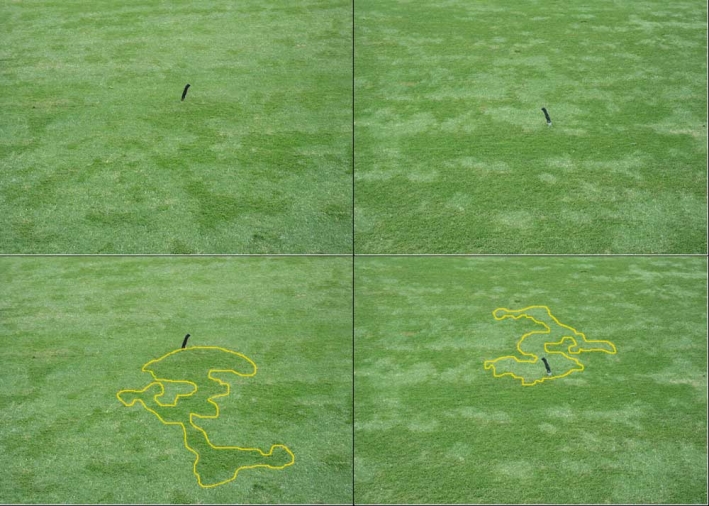 Sun angle can play tricks on your eyes and on the image that the camera captures. The composite image to the right illustrates the appearance of "grain" in hybrid bermudagrass. The dark object is the handle of a knife stuck into the turf. The images on the left versus those on the right were taken from opposite directions aiming toward the knife. In the bottom pair of images, the same area is outlined in yellow to illustrate how differently turf can look, depending on where you stand and how the light hits it. In other words, in order to understand what you are seeing and photographing, always view the turf from several angles before taking your photo
Sun angle can play tricks on your eyes and on the image that the camera captures. The composite image to the right illustrates the appearance of "grain" in hybrid bermudagrass. The dark object is the handle of a knife stuck into the turf. The images on the left versus those on the right were taken from opposite directions aiming toward the knife. In the bottom pair of images, the same area is outlined in yellow to illustrate how differently turf can look, depending on where you stand and how the light hits it. In other words, in order to understand what you are seeing and photographing, always view the turf from several angles before taking your photo
Exposure is controlled by four factors:
- Amount of light coming into the lens
- Sensitivity of the camera's sensor (ISO)
- Aperture (f-stop) setting
- Shutter speed
We generally do not have much control over how much light is coming into the lens, unless we are using supplemental lighting such as a flash. Therefore, the important factors are ISO, f-stop, and shutter speed. Each of these will be discussed below.
ISO is a measure of the sensitivity of the sensor in the camera and it is frequently adjustable. For low light conditions, ISO 200 or lower should be used. For situations where you are trying to stop motion (for example, when it is windy and objects are swaying in the breeze), the sensor is set to high ISO values (400 or higher). More expensive cameras provide a wider range of ISO values to allow photography without the need for supplemental lighting (in low light conditions) or to stop fast moving objects.
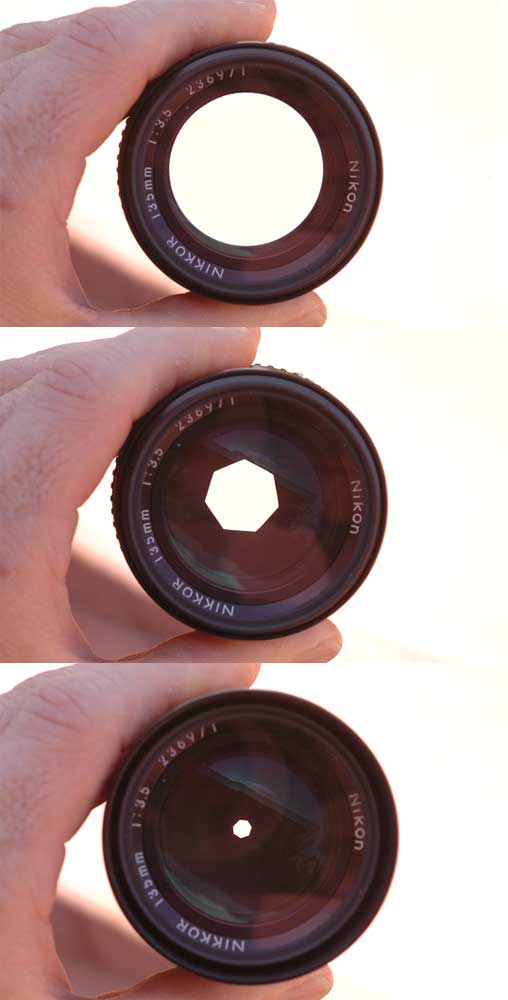 F-stop is simply a measure of the lens iris opening, or the aperture. The number represents the ratio of the focal length of the lens divided by the size of the iris opening. F-stops are frequently noted as a ratio such as f/16. The larger the f number (16 in this example) the smaller the opening, the less light will pass through to impact the sensor. The benefit of a small iris opening is that the depth of field is greater compared to a larger opening. Alternatively, small f-stop numbers indicate a wider aperture opening, more light coming through the lens, and a lessened depth of field. Click on the photo to the right to see how the aperture changes as the f-stop is changed. The table below illustrates the the differences caused by different f-stop settings and the resulting changes in depth of field as the iris opening changes. Note that as the iris opening decreases from f/4.5 to f/29, the shutter speeds (see below) were increased from 1/5000 sec to 1/160 sec to compensate for the reduced light that enters the lens.
F-stop is simply a measure of the lens iris opening, or the aperture. The number represents the ratio of the focal length of the lens divided by the size of the iris opening. F-stops are frequently noted as a ratio such as f/16. The larger the f number (16 in this example) the smaller the opening, the less light will pass through to impact the sensor. The benefit of a small iris opening is that the depth of field is greater compared to a larger opening. Alternatively, small f-stop numbers indicate a wider aperture opening, more light coming through the lens, and a lessened depth of field. Click on the photo to the right to see how the aperture changes as the f-stop is changed. The table below illustrates the the differences caused by different f-stop settings and the resulting changes in depth of field as the iris opening changes. Note that as the iris opening decreases from f/4.5 to f/29, the shutter speeds (see below) were increased from 1/5000 sec to 1/160 sec to compensate for the reduced light that enters the lens.
Shutter speed regulates the amount of light that is collected by the sensor after the light passes through the lens. Conventional film cameras had a physical barrier between the lens and the film that acts as the shutter, but many digital cameras operate by turning the sensor on and off for the designated period of time without the need for a shutter. The longer the shutter is open (or sensor is turned on), the more likely that movement of the subject will be detected and the more likely it is that the image will be blurry. Click on the thumbnail above to view a composite image that illustrates the impact of shutter speed on image quality when the subject is moving. Slow shutter speed can be used artistically to improve a photograph to emphasize movement. In most cases, however, fast shutter speeds, such as 1/125 sec or faster (1/250 sec, 1/500 sec etc) will provide an improved photo. If the lighting is low and fast shutter speed can't be used (because fast fast shutter doesn't allow in enough light), check the camera ISO setting to see if it can be increased to be more sensitive to light and to allow a faster shutter speed. Also check to be sure that the aperture is open to allow the maximum amount of light as discussed above. For shutter speeds below 1/125 sec, consider using a tripod to steady the camera.
Composition
For the artist, composition plays a major role in the visual impact of a the photograph. Though composition isn't as critical when communicating technical concepts, the best technical photos manage to combine both artistry and accuracy in the same picture. In other words, it is worthwhile to pay a little attention to composition - just don't let it override the considerations of focus, exposure and color described above.
There are many web sites that can help you with composition but we will mention one simple guide, the rule of thirds. When taking a photograph, the main subject of the image should be placed at one of the intersecting points where the image is broken into thirds vertically and horizontally.
Welcome to the PACE Newsroom
Untitled Document
This newsroom is provided as a resource for professional communicators who work with the turfgrass industry. The press releases, background information, graphics and photographs posted here are available for use in articles, broadcasts and other media formats, but we ask that you credit PACE Turf as the source of the information.
Micah Woods, Ph.D. To take Helm at PACE Turf
FOR IMMEDIATE RELEASE
SAN DIEGO, CA—June 28, 2022: Founders of PACE Turf, Drs. Larry Stowell and Wendy Gelernter, announce its acquisition by Dr. Micah Woods, President and Chief Scientist of the Asian Turfgrass Center (ATC). Dr. Woods will become director of the award-winning, science-based online turfgrass management information service, and Drs. Stowell and Gelernter will become visiting research directors. Dr. Woods will continue to oversee ATC research and education programs as he expands PACE Turf to meet the needs of today’s turfgrass management community, which includes golf course superintendents, sports turf managers, commercial and residential landscape managers worldwide.
The PACE Turf subscription information service delivers online, premier, science-based solutions to turf management problems using site-specific climate, weather and pest forecasting systems, breaking research news, information and expert advice that is customized for each PACE Turf member location. The website also hosts an extensive collection of turf management tools and guides, including the widely used Climate Appraisal form, that is available free of charge as a public service. The service debuted in 1992 with fax-based delivery, and as the technology became available, expanded to the online membership service available today, supporting turf managers around the world.
Dr. Woods said, "ATC has been a long-time collaborator with PACE Turf. Together we've introduced tools, such as the Minimum Levels for Sustainable Nutrition (MLSN) guidelines that have been adopted worldwide and helped turf managers reduce inputs while maintaining high quality turf. I'm immensely proud of these achievements and look forward to continuing PACE Turf's long tradition of delivering expert and practical turf management guidance."
Drs. Stowell and Gelernter have overseen PACE Turf since its inception. Dr. Gelernter said, “We can't imagine anyone better suited than Micah to take on PACE Turf's mission."
Dr. Woods established ATC in 2006 after working as a golf course superintendent in China and Japan and upon completion of graduate studies at Cornell University. Since then, his research and educational activities have led to the international recognition of ATC. His work as a consultant, researcher and speaker has taken him to more than 30 countries on five continents. Through the ATC, he provides turfgrass advisory and soil testing services to clients around the world. Since 2009, he has also been an Adjunct Professor in the Department of Plant Sciences at the University of Tennessee.
"We know that Micah will maintain the vast store of information already available on the PACE Turf website,” Dr. Stowell said. “Plus he will continue to raise the level of practical turf management guidance as new research and findings develop in turf science. His work with ATC is truly synergistic with PACE Turf, and we know that PACE Turf members will reap the benefits of that."
Memberships for the PACE Turf information service are available for $275 annually. Members receive their site-specific climate, weather and pest forecasting services via email or direct access to the website. At any time, members can visit the PACE Turf website to view the pest and disease photo gallery, find management solutions via the website’s extensive reference collection and review timely updates from the PACE Turf research staff. Subscribe to PACE Turf’s online information service at https://paceturf.org/members/signup.
For more information on Dr. Woods’ work at PACE Turf and ATC, visit www.paceturf.org and www.asianturfgrass.com. Find us on Twitter as @asianturfgrass and @paceturf. Email Dr. Woods at micah@asianturfgrass.com or woods@paceturf.org.
The Asian Turfgrass Center works with turf managers globally to provide expert and unbiased advice on how to best obtain desired turfgrass conditions. Its website at www.asianturfgrass.com/ contains information that is used by turfgrass managers around the world.
PACE Turf is a membership organization that provides breaking research news, information and expert advice on its website at www.paceturf.org The mission of PACE Turf is to generate and share independent and objective agronomic information for turf professionals, so they may develop management programs that are effective, practical and scientifically sound.
Media Contact:
Micah Woods, Ph.D.
micah@asianturfgrass.com
woods@paceturf.org
GENERAL
EC (electrical conductivity) monitoring for soil salinity
If you are concerned that high soil salinity may be damaging your turfgrass, we suggest that you consider a regular monitoring program with an electrical conductivity meter. The method for using the meter to keep track of salinity and to trigger leaching events is described in the Monitoring Soil Salinity PACE Reference (29 KB pdf).
Sign Up
You can become involved with the PACE Turfgrass Research Institute in the following ways:
- By joining ($325/year), you will receive full membership benefits as well as access to PACE Surveys, Forums, Super Journal and the Photo Gallery.
- By registering (Free), you will receive free access to PACE’s Pest Surveys, Forums, Super Journal and the Photo Gallery.
- By signing up for a free trial membership you will receive PACE’s weekly email updates (sent out every Monday) for three consecutive weeks. These publications are one of the core components of PACE membership and feature current news and research on pest and turf trends from around the country, as well as information on new and effective management strategies.
What is CVV2
Card Verification Value, or CVV2, is a security measure that we require for all credit card transactions. Since the CVV2 number is listed on your credit card, but not stored in other locations, the only way to know the correct CVV2 is to have the card in your possession. All Visa, MasterCard and American Express cards now have this security feature.
How to find your CVV2 number
For Visa or MasterCard, turn your card over and look in the signature strip. You will find either the entire credit card number or just the last 4 digits of the credit card number followed by a space and a 3-digit number. That 3-digit number is your CVV2 number. If you can not read the CVV2 number, you will have to contact your card issuer or mail in your payment.
For American Express, the number is imprinted on the front of the card and to the right side above the last few digits of the account number.
Visa and MasterCard

American Express

Directors, founders, and scientists
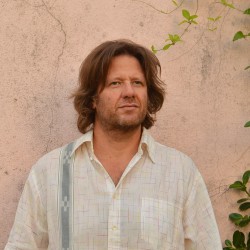 Micah Woods, Ph.D. is the director of PACE Turf as well as the founder and chief scientist of the Asian Turfgrass Center (ATC). Since graduating from Oregon State University in 1998, Micah has been traveling extensively, collecting data, and advising turfgrass managers across Asia, Australia, North America, and Europe. From 2001 to 2005, he was in New York to study with Frank Rossi at Cornell University. The broad scope of his research on grasses around the world led to his collaboration with PACE Turf to create the MLSN guidelines which are applicable to turf in all climate zones, or as he says, “any grass, anywhere.”
Micah Woods, Ph.D. is the director of PACE Turf as well as the founder and chief scientist of the Asian Turfgrass Center (ATC). Since graduating from Oregon State University in 1998, Micah has been traveling extensively, collecting data, and advising turfgrass managers across Asia, Australia, North America, and Europe. From 2001 to 2005, he was in New York to study with Frank Rossi at Cornell University. The broad scope of his research on grasses around the world led to his collaboration with PACE Turf to create the MLSN guidelines which are applicable to turf in all climate zones, or as he says, “any grass, anywhere.”
You can read more about Micah’s unique take on tending turfgrass in his book, A Short Grammar of Greenkeeping, as well as on his ATC website. If you have the pleasure of hearing Micah speak at a conference, you may notice that he frequently dons a bow tie and sports some unusual hairstyles. A devoted Dickens fan, Micah has read all of his novels, from Barnaby Rudge to A Tale of Two Cities. Micah is inspired as much by clever turns of phrase and stunning mountaintop views as he is by solving problems, creating graphs, and discovering unexpected statistics.
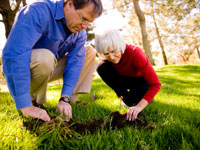
Wendy Gelernter, Ph.D. and Larry J. Stowell, Ph.D. are PACE Turf’s founders and currently serve as visiting research directors. Their complimentary backgrounds in entomology, plant pathology, agronomy and crop science, combined with their interest in translating turfgrass research into practical management solutions were the basis of their work at PACE Turf. In addition to being business partners, Wendy and Larry have been married since 1986, and live in San Diego, California.
Wendy Gelernter is an entomologist who received her B.S. from Cornell University 1976 and her Ph.D. from the University of California, Riverside in 1984. Before joining PACE in 1995, Wendy was the Director of Commercial Development for the agricultural biotechnology company Mycogen Corporation, where she worked for 11 years. Wendy is the author of numerous scientific publications and has served in leadership positions for several professional organizations including the Society for Invertebrate Pathology, the Entomological Society of America, and the Association of Applied IPM Ecologists. She is a past President of the Society for Invertebrate Pathology and serves on the editorial board of the scientific publication, Biocontrol Science and Technology.
Larry J. Stowell founded PACE Consulting in 1986 and the PACE Turfgrass Research Institute in 1993. The research and consulting businesses were blended together and renmaed PACE Turf in 2008. He is a plant pathologist, certified professional agronomist, licensed pest control advisor and qualified applicator who received his training at the University of Arizona, where he obtained his B.S. and Ph.D., and at the University of California, Davis, where he conducted post-doctoral research until 1982. Before founding PACE, Larry was the Director of Mycoherbicide Development at the agricultural biotechnology company, Mycogen Corporation. He is the author of numerous scientific publications and two patents, and has served in leadership positions for several professional organizations including the American Phytopathological Society, American Society of Agronomy, National Alliance of Independent Crop Consultants and the Association of Applied IPM Ecologists. He served on the Editorial Board of Applied Turfgrass Science.
Refund Policy
For immediate access to PACE Turf's dozens of member benefits, you are urged to Join PACE Turf
We take great pride in the quality of the services and information that are offered to PACE Turf members and have never yet had to issue a refund. However, if you are not satisfied with the membership services, we will accept cancellation of your membership at any time by refunding a portion of your annual membership fee (as determined by the time elapsed since your subscription was initiated), as indicated below.
| Number of days after membership initiation | Percent refunded |
| 0-30 | 80% |
| 31-60 | 60% |
| 61-90 | 40% |
| greater than 90 | 0% |
Please contact PACE Turf to request a refund. You can contact us by phone at: 858.272.9897 or by email using the Contact us link. Refunds will be issued by check if the original payment was made by check. If the original payment was made by credit card, refunds will be issued by credit card.
PACE Turf's refund policy, as currently published herein, represents PACE Turf's sole obligation with respect to PACE Turf membership refunds.
User agreement
This user agreement covers the terms and conditions for users of the PACE Turf PUBLIC website ("PUBLIC website") and the PACE Turf member website ("Member website").
PUBLIC WEBSITE
If you choose to register on the PACE Turf PUBLIC website (“PUBLIC website”), you will be agreeing to abide by all of the terms and conditions of the agreement below.
The PUBLIC website is provided by PACE Turf as a free PUBLIC service to the turf management community in order to promote education, communication and improved agronomic practices for turfgrass. Unless otherwise specified, you are encouraged to share, copy or distribute the contents of the PUBLIC website for any non-profit, educational purpose, without obtaining additional permission. All images must retain the photographer’s credits (if they are present) for all usages. For permission to use any of the contents of PUBLIC website for commercial or for-profit uses, Contact us.
The content of the PUBLIC website includes:
- Super Journal: electronic journal for PUBLICation of applied turfgrass research conducted by superintendents, turf managers, researchers and consultants.
- Home page
- Tour of membership benefits
Changes to this agreement:
PACE Turf may change, add or remove portions of this Agreement at any time, but if it does so, it will post such changes on the appropriate website.
Endorsements:
You acknowledge that the opinions and recommendations contained in this Website are not necessarily those of PACE Turf or endorsed by PACE Turf. PACE Turf may provide links on the Website to other websites which are not under the control of PACE Turf. These links are provided for convenience of reference only and are not intended as an endorsement by PACE Turf or the organization or individual operating the website or a warranty of any type regarding the website or the information on the website.
Representations and warranties:
You represent, warrant and covenant that no materials of any kind submitted through your account will violate, plagiarize, or infringe upon the rights of any third party, including copyright, trademark, privacy or other personal or proprietary rights; or contain libelous or otherwise unlawful material. You hereby indemnify, defend and hold harmless PACE Turf from and against any and all liability and costs, including, without limitation, reasonable attorneys' fees in connection with any claim arising out of any breach by you or any user of your account of this Agreement or the foregoing representations, warranties and covenants. You shall cooperate as fully as reasonably required in the defense of any such claim.
Neither PACE Turf nor the PUBLIC Website represent or endorse the accuracy or reliability of any advice, opinion, statement, or other information displayed, uploaded, or distributed through this service by any user, information provider or any other person or entity. You acknowledge that any reliance upon any such opinion, advice, statement, memorandum, or information shall be at your sole risk. THE PUBLIC WEBSITE AND ALL DOWNLOADABLE SOFTWARE ARE DISTRIBUTED ON AN "AS IS" BASIS WITHOUT WARRANTIES OF ANY KIND, EITHER EXPRESS OR IMPLIED, INCLUDING, WITHOUT LIMITATION, WARRANTIES OF TITLE OR IMPLIED WARRANTIES OF MERCHANTABILITY OR FITNESS FOR A PARTICULAR PURPOSE. YOU HEREBY ACKNOWLEDGE THAT USE OF THE PUBLIC WEBSITE IS AT YOUR SOLE RISK.
Correspondence should be sent to:
PACE Turf
1267 Diamond St.
San Diego, CA 92109 USA
MEMBER WEBSITE
If you choose to use the PACE Turf Member Website (“Member Website”), you will be agreeing to abide by all of the terms and conditions of the agreement below.
The contents of the Member website are intended for your personal, noncommercial use. All materials published on the Member website (including, but not limited to PACE Turf Insights, PACE Turf References, PACE Turf Clubhouse Editions, PACE Turf Updates, Weather , Weather History, Photo Gallery and Member Forums, collectively also known as “Content”) are protected by copyright, and are owned or controlled by PACE Turf, or the party credited as the provider of the Content. You may not modify, publish, transmit, participate in the transfer or sale of, reproduce (except as provided in the paragraph below), create new works from, distribute, perform, display, or in any way exploit, any of the Content or the Member website (including software) in whole or in part.
You may download or copy the Content and other downloadable items displayed on the Member website for personal use only, provided that you maintain all copyright and other notices contained therein. Copying or storing of any Content for other than personal use is expressly prohibited without prior written permission from PACE Turf or the copyright holder identified in the copyright notice contained in the Content.
Members of PACE Turf have access to all of the Content of both the PACE Turf PUBLIC website, as well as to the Content of the Member Website which includes, but is not limited to:
- PACE Turf Updates: frequently posted updates on current pest and turf trends (members only)
- Weather and Weather History : site-specific weather, pest and agronomic information (members only)
- PACE Turf Insights: monthly in-depth technical reviews (members only)
- PACE Turf References: guidelines, monitoring procedures and references on turfgrass soil, water and pest management (members only)
- PACE Turf Highlights: monthly newsletter (members only)
- PACE Turf Clubhouse Editions: educational literature on turf management practices intended for golfers (members only)
- Member Forums: interactive discussions among members on turf management issues (members only)
- PACE Turf Archives: comprehensive compilation of turf management literature (members only)
- Photo Gallery: turf management images and photographs (members only)
- Super Journal: electronic journal for publication of applied turfgrass research conducted by superintendents, turf managers, researchers and consultants.
Changes to this agreement:
PACE Turf may change, add or remove portions of this Agreement at any time, but if it does so, it will post such changes on the appropriate website.
PACE Turf may change, suspend or discontinue any aspect of its membership services at any time, including the availability of any feature, database, or content. PACE Turf may also impose limits on certain features and services or restrict your access to parts or all of the PUBLIC Website and/or the Member Website without notice or liability.
Forum rules and etiquette:
Courteous and respectful language must be used at all times. You shall not upload to, or distribute or otherwise publish on the Forums any libelous, defamatory, obscene, pornographic, abusive, or otherwise illegal material. You agree that you will not threaten, personally attack or verbally abuse other participants, use defamatory language, or deliberately disrupt discussions with repetitive messages, meaningless messages or "spam." You agree not to use language that abuses or discriminates on the basis of race, religion, nationality, gender, sexual preference, age, region, disability, etc.
Forums shall be used only in a noncommercial manner. You shall not, without the express approval of PACE Turf, distribute or otherwise publish any material containing any solicitation of funds, advertising or solicitation for goods or services.
You are solely responsible for the content of your messages. However, while PACE Turf does not and cannot review every message posted by you on the Forums and is not responsible for the content of these messages, PACE Turf reserves the right to delete, move, or edit messages that it, in its sole discretion, deems abusive, defamatory, obscene, in violation of copyright or trademark laws, or otherwise unacceptable.
You acknowledge that any submissions you make to the PUBLIC Website or the Member Website may be edited, removed, modified, published, transmitted, and displayed by PACE Turf and you waive any moral rights you may have in having the material altered or changed in a manner not agreeable to you.
You represent, warrant and covenant that no materials of any kind submitted through your account will (i) violate, plagiarize, or infringe upon the rights of any third party, including copyright, trademark, privacy or other personal or proprietary rights; or (ii) contain libelous or otherwise unlawful material.
Endorsements:
You acknowledge that the opinions and recommendations contained in this Website are not necessarily those of PACE Turf or endorsed by PACE Turf. PACE Turf may provide links on the Website to other websites which are not under the control of PACE Turf. These links are provided for convenience of reference only and are not intended as an endorsement by PACE Turf of the organization or individual operating the website or a warranty of any type regarding the website or the information on the website.
Representations and warranties:
You represent, warrant and covenant that no materials of any kind submitted through your account will violate, plagiarize, or infringe upon the rights of any third party, including copyright, trademark, privacy or other personal or proprietary rights; or contain libelous or otherwise unlawful material. You hereby indemnify, defend and hold harmless PACE Turf from and against any and all liability and costs, including, without limitation, reasonable attorneys' fees in connection with any claim arising out of any breach by you or any user of your account of this Agreement or the foregoing representations, warranties and covenants. You shall cooperate as fully as reasonably required in the defense of any such claim.
Neither PACE Turf nor the PUBLIC Website or the Member Website represent or endorse the accuracy or reliability of any advice, opinion, statement, or other information displayed, uploaded, or distributed through these services by any user, information provider or any other person or entity. You acknowledge that any reliance upon any such opinion, advice, statement, memorandum, or information shall be at your sole risk. THE PUBLIC WEBSITE AND ALL DOWNLOADABLE SOFTWARE ARE DISTRIBUTED ON AN "AS IS" BASIS WITHOUT WARRANTIES OF ANY KIND, EITHER EXPRESS OR IMPLIED, INCLUDING, WITHOUT LIMITATION, WARRANTIES OF TITLE OR IMPLIED WARRANTIES OF MERCHANTABILITY OR FITNESS FOR A PARTICULAR PURPOSE. YOU HEREBY ACKNOWLEDGE THAT USE OF THE PUBLIC WEBSITE AND Member WEBSITE IS AT YOUR SOLE RISK.
Membership:
Paid membership in PACE Turf is required to obtain access to the Member Website. Free trial memberships of limited duration will periodically be made available for promotional purposes. however. For more information about membership in PACE Turf, see our documents on Member Benefits and on Joining PACE Turf.
As part of initiating your membership, you will select a password and a user name. You may not use a Member ID that PACE Turf, in its sole discretion, deems offensive.
PACE Turf is committed to protecting your privacy. We do not rent, sell or share the personal information that you provide to us with any other people or organizations for any purpose. For more information, see our Privacy Policy
Termination:
You may terminate your membership at any time by contacting PACE Turf at the address below. The Refund Policy provides information on refund of membership fees.
PACE Turf may, in its sole discretion, terminate or suspend your access to the Member Website for any reason, including, without limitation, breach or assignment of this Agreement. If access to the Member Website is terminated by PACE Turf, funds will be refunded in accordance with the Refund Policy.
Correspondence:
Correspondence should be sent to:
PACE Turf
1267 Diamond St.
San Diego, CA 92109 USA
Turf Management Guidelines
Turf growth potential in selected U.S. locations
Turf growth potential at different average air temperatures
EC (electrical conductivity) monitoring for soil salinity
Soil Guidelines and demystifying soil analyses
Soil Chloride and Sulfur Guidelines
Links of Interest
Pesticide labels and MSDS
Food and Agriculture Organization (FAO) Handbook 29, “Water Quality for Agriculture”
CDMS pesticide labels and MSDS sheets searchable by product name and manufacturer
The best scientific literature site for starting a search for turfgrass related information:
Turfgrass Information File at Michigan State University. - subscription needed. This site should be your first stop when searching for research information in the turfgrass arena
University sites of interest:
North Carolina State University Turffiles - this site has a good archive library for presentations made by several professors including Dr. Fred Yelverton, Dr. Leon Lucas, and Dr. Lane Tredway and links to their disgnostic laboratory
Maryland Turf Council’s listing of Turf Publications
Golf Course Superintendent’s Association of America
GCSAA
Chicago District Golf Association Turfgrass Program
CDGA Turf Program
Popular Golf Course Superintendent’s Community Site:
Turfnet
National Turfgrass Evaluation Program:
NTEP
Program for April 7, 2006 PACE Turfgrass Research Seminar
7:15 REGISTRATION and CONTINENTAL BREAKFAST
8:00 An introduction to precision management: IPM, GPS and GIS. Dr. Larry Stowell, PTRI
8:45 New information on rapid blight biology and management. Dr. Mary Olsen, University of Arizona
9:15 Precision tools for 21st century turf IPM programs. Dr. Wendy Gelernter, PTRI
10:00 BREAK
10:15 Managing for firm greens: can it be achieved within an IPM framework? Dr. Larry Stowell, PTRI.
11:00.Going deeper with white grubs: hidden problems and new solutions. Dr. Wendy Gelernter, PTRI
11:45 LUNCH AND TRADE SHOW
12:45 Photography for IPM. Dr. Larry Stowell, PTRI.
1:30 Effects of water quality and quantity on IPM programs for bermudagrass. Dr. Shoumo Mitra, Cal Poly Pomona.
2:15 University of California Disease Update for 2006. Dr. Frank Wong, UC Riverside
3:00 BREAK
3:15 Another look at poa management on greens and fairways. Dr. Wendy Gelernter, PTRI
ADJOURN 4:00 pm
There are three ways to register:
- Register online
- Register by mail: Print out a registration form, complete and mail, with payment, to PACE, 1267 Diamond St., San Diego, CA 92109
- Register by phone by calling 858-272-9897
Site Map
| Public Accessible | Members Only |
|---|---|
| Home Super Journal Search Testimonials |
Updates Search Recent Entries Categories Cultural Practices |
Contact us
PACE Turf LLC
1267 Diamond St.
San Diego, CA 92109 USA
Phone: 858-272-9897
![]()
Acceptable Use
The contents of the PACE Turfgrass Research Institute (PTRI) website are intended for your personal, noncommercial use. All materials published on the PTRI website (including, but not limited to PACE Insights, PACE References, PACE Clubhouse Editions, presentations, research reports and photos, also known as “Content”) are protected by copyright, and are owned or controlled by the PACE Turfgrass Research Institute, or the party credited as the provider of the Content. You shall abide by all additional copyright notices, information, or restrictions contained in any Content accessed through the PTRI website.
The PACE Turfgrass Research Institute website and its Contents are protected by copyright pursuant to U.S. and international copyright laws. You may not modify, publish, transmit, participate in the transfer or sale of, reproduce (except as provided in the paragraph below), create new works from, distribute, perform, display, or in any way exploit, any of the Content or the PTRI website (including software) in whole or in part.
You may download or copy the Content and other downloadable items displayed on the PTRI website for personal use only, provided that you maintain all copyright and other notices contained therein. Copying or storing of any Content for other than personal use is expressly prohibited without prior written permission from the PACE Turfgrass Research Institute or the copyright holder identified in the copyright notice contained in the Content.
Privacy Policy
PACE Turf is committed to protecting your privacy. We do not rent, sell or share your personal information with any other people or organizations for any purpose. The following discloses our information collection and use practices.
Information collection: To view free public services on the homepage, the tour or Super Journal, it is not necessary to join PACE Turf. However, PACE Turf membership is required for access to restricted areas including Updates, Weather, Insights, Clubhouse Editions, Gallery, References and Highlights. When you join, we will request that you provide personal information such as your name, e-mail address, street address or phone number for membership initiation. This personal information is used to communicate with customers and to verify identity during support and customer service requests. PACE Turf uses a member ID number, an assigned site member name (user name), and a password chosen by our members and registered participants to permit them access to our restricted services. We use your IP address as recorded in our site logs only as needed to help diagnose problems with our server, and to administer our Web site. We do not use IP address logs to track your session or your behavior on our site, and they are not shared with other sites.
Credit card transactions: All credit card transactions conducted during a transaction with the PACE Turf Website are executed using Stripe and a Token-based information exchange so that no credit card information is stored on PACE Turf servers. Stripe, a GDPR compliant business conducts the actual transaction.
Cookie technology: PACE Turf uses browser cookies to improve web navigation on the member pages, and to save access permissions for our members so that they do not have to log in multiple times as they attempt to access restricted pages during a single online session. These cookies do not contain any Personally Identifiable Information (PII), and are not shared with any other web site. Users who do not accept cookies from the domain www.paceturf.org may not be able to access most areas of the PACE Turf website.
Corrections and updates: Members may change their membership information (password, contact information) at any time by logging in, clicking on the the My Account section and making the appropriate changes in the "Change password/edit profile" area.
If you have questions about the privacy policy, please Contact us .
Membership Benefits
We invite you to join the world’s best informed turf managers by becoming a member of the PACE Turfgrass Research Institute today. For an annual fee of $325.00, members will receive a wealth of printed, emailed and on-line information. Take the PACE Tour for more information on membership benefits.
Who We Are
PACE Turf was founded in 1988 by Larry Stowell, Ph.D. and Wendy Gelernter, Ph.D. to provide expert, objective, science-based advice and information to the turf management community. Using research results, on-the-ground experience, and their over 70 years of combined knowledge in agronomy, plant pathology, entomology, weed science and turf science, PACE Turf has long been a leader in translating science into practical turf management information, and in helping turf managers prevent problems before they occur.
In 2022, Micah Woods, Ph.D acquired the PACE Turf information service after collaborating with Drs. Stowell and Gelernter for many years.
PACE Turf offers a membership information service that delivers science-based solutions to turf management problems with breaking research news, information and expert advice on products, practices, pests and weather threats. With information customized specifically for each member's location, PACE Turf delivers its clear, bottom-line conclusions via email alerts and an information-filled website that is uncluttered by advertising. To learn more about the benefits of PACE Turf membership, click here or sign up here.
Free public services offered on the commercial-free PACE Turf website include access to turf management guidelines on pests, soils, water and plant analysis. In addition, PACE Turf’s Super Journal is an online turf research publication containing turf research reports written by golf course superintendents and turf researchers, on topics ranging from turf IPM or integrated pest management, to soil, water and irrigation management, to new advances in turf monitoring practices and procedures.
Quick test for soil nitrate
We have developed a quick, easy, on-site test that can detect excessive levels of soil nitrates. Although this test does not replace analytical testing, it provides values that are rough estimates of nitrate levels, and should be a useful and rapid diagnostic tool.
Materials needed:
- Hach water test strips for nitrate/nitrite (Cat. # 27454-25, Hach Company, PO Box 389, Loveland, CO 80539. Phone: 800-227-4224. A bottle of 25 strips is $16.29 as of July, 2010.
- Small beaker or container
- Tablespoon
- Soil from problem area and from nearby area of healthy turf
- Notebook for recording data
Procedure:
- Mix equal volumes of soil and tap water (for example, 1 tablespoon of each) in a small container and stir thoroughly. Allow the soil to settle for 1 minute
- Dip the test strip into the soil suspension.
- Allow the strip to develop for 1 minute
- Lightly rinse the strip with water to remove soil
- Compare the color on the tip of the strip to the nitrate nitrogen color chart on the test strip container. Write down the ppm value that you think is closest to the color you see on the strip. This value must be converted to obtain the nitrate concentration (in parts per million) of your soil, using the formula below:
(Dipstick value X 1.5) + 2.9 = Soil nitrate concentration (ppm)
For example, assume that the color on your dipstick indicates roughly 15 ppm nitrate, as it does in this photo. Remember -- the dipstick value needs to be converted to one that is accurate for soil nitrate! The soil nitrate concentration is therefore = (15 X 1.5) + 2.9 = 24.9.
- If the final value is over 20 ppm as it is in the example above, nitrogen applications of all types should be halted until levels are well below 20 ppm. If possible, leach the area to help bring nitrogen levels down more rapidly.
Keep in mind that the dipstick test has several limitations, including:
- It does not test for ammonium levels -- only for nitrate levels. Therefore, even if you have high ammonium levels in your soils, you will get a low reading from the dipstick.
- The test is designed to detect an excess of nitrogen, but it will not detect nitrogen deficits. To determine whether your soils are lacking in nitrogen, the soils should be sent to an analytical laboratory.
- The values you get with this test are rough estimates, at best. For more accurate readings, soils should be sent to an analytical lab for testing.
Turf Resources
PACE Turf makes this information available as a public service to the turf management community. You can support our research and education programs by becoming a PACE Turf member today. Members also receive access to PACE Turf's award winning information service, an indispensable resource for all of those in the turf industry.
Pest management publications
- Fungicides and the diseases they control
- Turfgrass disease diagnostic laboratories
- Fungicide combination products: decision making tools
- PACE Turf disease photo index
- PACE Turf insect photo index
- PACE Turf video library
- IPM Planning Tools
- Climate appraisal forms and instructions
Soil management guidelines
- Minimum levels for sustainable nutrition soil guidelines
- EC (electrical conductivity) monitoring for soil salinity
- Soil Chloride and Sulfur Guidelines
- Soil analytical laboratories
- Quick test for soil nitrate
Other agronomic guidelines and tools
- Irrigation audit procedure
- Tissue Guidelines
- Water Guidelines
- Recycled Water
- Food and Agriculture Organization (FAO) Handbook 29, "Water Quality for Agriculture"
Useful websites
Turf Research
- How we review products and practices
- Research Guide - conduct your own research
- Super Journal: an online turf research resource
Impact of Weather and Climate on Turf Quality
- Turf growth potential in selected U.S. locations
- Turf growth potential at different average air temperatures
A message from PACE Turf owners, Dr. Wendy Gelernter and Dr. Larry Stowell:
If you join PACE Turf today, you will have immediate access to weekly emailed updates, educational videos, site-specific weather and pest forecasts, and a state of the art website that will help you to prevent turf problems before they occur, save you time and money, and keep you current with the newest management products and practices. At $275 per year, or just $ 0.75 per day, it's a bargain that you can't afford to miss out on!
For more information on PACE Turf member benefits, please take the tour of PACE Turf member services, or read what other turf managers have to say about the benefits of membership.
Root Zone Bulk Density and Rapid Blight
The bulk density of a soil is a combination measure of the particle density and how tightly packed the particles are in the sample. Under ideal conditions, the bulk density of a soil is a measure of soil pore space and can therefore provide important information on the degree of compaction on golf course greens. In this article, the theoretical basis behind the bulk density measurement will be reviewed and its possible applications will be discussed through presentation of data recently generated at California golf courses.
Full print version: PACE Insights 1995 Vol. 1 No. 12
Announcements
Our list of 2024 University Field Days
For print publications on soil, water and pest management guidelines, check out our Turf Resources page.
Micah Woods, Ph.D. takes the helm at PACE Turf
Sign up for the free MLSN Newsletter to keep up with the latest news on implementing these nutrient management guidelines.

